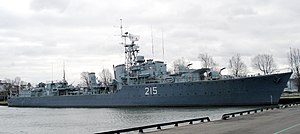 HMCS Haida, a Canadian Tribal-class destroyer and the only Tribal-class destroyer to be preserved
| |
| Class overview | |
|---|---|
| Builders | |
| Operators | |
| Preceded by | I class |
| Succeeded by | J class |
| In commission | 1938–1963 |
| Planned | 32 |
| Completed | 27 |
| Cancelled | 5 |
| Lost | 13 |
| Scrapped | 13 |
| Preserved | 1 |
| General characteristics | |
| Type | Destroyer |
| Displacement | |
| Length | 377 ft (115 m) (o/a) |
| Beam | 36 ft 6 in (11.13 m) |
| Draught | 11 ft 3 in (3.43 m) |
| Installed power |
|
| Propulsion | 2 × shafts; 2 × geared steam turbines |
| Speed | 36 knots (67 km/h; 41 mph) |
| Range | 5,700 nmi (10,600 km; 6,600 mi) at 15 knots (28 km/h; 17 mph) |
| Complement | 190 (219 in flotilla leaders) |
| Sensors and processing systems | ASDIC |
| Armament |
|
The Tribal class, or Afridi class, was a class of destroyers built for the Royal Navy, Royal Canadian Navy and Royal Australian Navy that saw service in World War II. Originally conceived during design studies for a light fleet cruiser,[1] the Tribals evolved into fast, powerful destroyers, with greater emphasis on guns over torpedoes than previous destroyers, in response to new designs by Japan, Italy, and Germany.[2] The Tribals were well admired by their crews and the public when they were in service due to their power, often becoming symbols of prestige while in service.[3]
As some of the Royal Navy's most modern and powerful escort ships, the Tribal class served with distinction in nearly all theatres of World War II. Only a handful of Royal Navy Tribals survived the war, all of which were subsequently scrapped from hard use, while Commonwealth Tribals continued to serve into the Cold War, serving with distinction in the Korean War. Only one Tribal survives to this day: HMCS Haida, which is now a museum ship in Hamilton Harbour, Ontario, Canada.
- ^ Cite error: The named reference
NelsonVanguardwas invoked but never defined (see the help page). - ^ Cite error: The named reference
ConwayTribalwas invoked but never defined (see the help page). - ^ Hadley, Michael L. (1996). A Nation's Navy: In Quest of Canadian Naval Identity. Montreal: McGill-Queen's Press. pp. ?.